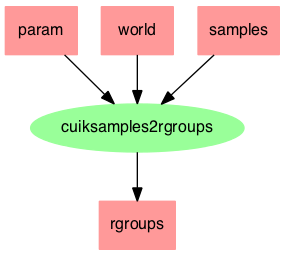|
cuiksamples2rgroups.c File Reference Detailed Description
This application takes a world file and a sample and generates a file with the atoms grouped by rigid groups. These input files are used to test the RigidCLL library. This is a proximity/collision detection library specially designed to be efficient when the atoms are grouped in rigid groups. This algorithm is described in our paper: - V. Ruiz de Angulo, J. Cortés, J. M. Porta, <a href="http://www.iri.upc.edu/publications/show/1269">Rigid-CLL: Avoiding Constant-distance Computations in Cell Linked-Lists Algorithms</a>, Journal of Computational Chemistry, Vol. 33, No. 3, pp. 294-300, 2012. . Thus, this application is only used to generate test files for the RigidCLL library and, therefore, it is not directly used in the CuikSuite application. Note that this application can operate on any world file, irrespectively whether it comes from a molecule or not. The operation basically considers any sphere in the world as an atom and stores its center and radius in the given configuration. Definition in file cuiksamples2rgroups.c.
Function Documentation
This application takes a world file and a sample and generates a file with the atoms grouped by rigid groups. These input files are used to test the RigidCLL library. This is a proximity/collision detection library specially designed to be efficient when the atoms are grouped in rigid groups. This algorithm is described in our paper: - V. Ruiz de Angulo, J. Cortés, J. M. Porta, <a href="http://www.iri.upc.edu/publications/show/1269">Rigid-CLL: Avoiding Constant-distance Computations in Cell Linked-Lists Algorithms</a>, Journal of Computational Chemistry, Vol. 33, No. 3, pp. 294-300, 2012. . Thus, this application is only used to generate test files for the RigidCLL library and, therefore, it is not directly used in the CuikSuite application. Note that this application can operate on any world file, irrespectively whether it comes from a molecule or not. The operation basically considers any sphere in the world as an atom and stores its center and radius in the given configuration. Use:
where
The extension are optional. An example of use can be
This generates a file (ex1.rgroups) into the RigidCLL folder form the information in the examples/Bio/1EJ0.world (which in turns comes from a PDB file using the cuikpdb2world application).
Definition at line 89 of file cuiksamples2rgroups.c. References CreateFileName(), CT_REPRESENTATION, DeleteFileName(), DeleteParameters(), DeleteWorld(), Error(), FALSE, GetFileFullName(), GetParameter(), GetWorldNumSystemVariables(), InitParametersFromFile(), InitWorldFromFile(), IsMechanismInWorldAllSpheres(), JOINTS_EXT, LINKS_EXT, NEW, PARAM_EXT, REP_JOINTS, RGROUPS_EXT, TRUE, Warning(), WORLD_EXT, and WorldStoreRigidGroups(). | ||||||||||||||||||||||||
Follow us!